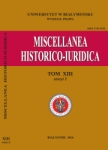Adulteresses and fornicatresses in Serbian law in the first half of the XIX century
Adulteresses and fornicatresses in Serbian law in the first half of the XIX century
Author(s): Sanja M. GligićSubject(s): Law, Constitution, Jurisprudence, History of Law, 19th Century, Canon Law / Church Law
Published by: Wydawnictwo Uniwersytetu w Białymstoku
Keywords: adulteresses; fornicatresses; legal rules; custom rules; canonical rules;
Summary/Abstract: During the first and second Serbian uprisings, under the influence of historic, social, cultural and ethnic processes which played a significant role in forming and developing the Serbian state, women were punished for the criminal acts of adultery and fornication, which is proven by a large number of verdicts, but also by custom and canonical rules which stipulated specific sanctions in these cases. It can be concluded from mentioned verdicts in cases of adultery that the penal policy enforced by Karadjordje (First Uprising) was milder compared to the penal policy of Grand Duke Miloš (Second Uprising). At the time of Miloš’s rule, on the evidence of preserved rulings, it can be seen that in the period between 1825 and 1828 adulteresses faced corporal punishment involving 50 to 100 lashes of the whip and/or exile in cases where the adultery was committed with a Turk. The period between 1837 and 1843 is characterized by a milder penal policy similar to that from the time of Karadjordje’s rule (25 lashes of the whip), and even milder (10 lashes of the whip or 25 strokes of the stick) but with one difference – aside from corporal punishment jail terms were also frequently applied albeit for only short periods of time. As for the punishing of fornicatresses, as opposed to the punishing of adulteresses, there is a discrepancy between canonical and customary rules on one side and legal regulations on the other. Fornicators were most frequently awarded the sentence of whipping (12 to 50 lashes), but in several cases of fornicator deliberation, verdicts were recorded regardless of the circumstances involved. If the misbehavior of a girl was discovered before her marriage, she (and her entire family) would be exposed as a laughing-stock, the chances of a regular marriage became minimal, and the most violent reaction of the village was to stone or exile the offender. Sanctions stipulated by two legal systems – clerical canons and customary law norms, when it came to the criminal acts of adultery and fornication, were in essence almost identical in that both the church and the village stipulated the harshest fine for female transgressors – their excommunication. The basic sanctions imposed by the Orthodox Church against “fallen” female members of the community ranged from the mild – denial of communion over a certain period of time, to those which, aside from the holy communion, also denied a female transgressor the presence during the second part of liturgy after prayer for non-christened, and the anathema – excommunication, which included exclusion from the church community (this was practiced in the most severe cases). These were not fines in the true sense of the word, but were more like categories of the present spiritual state of a particular member of the church, regardless of the type of transgression committed. However, the “sinner” always had to repent and return back to the community. This was the true purpose of these penances. As far as the customary law is concerned, it is known that it developed under a certain set of circumstances. Serbia, when it fell under Turkish rule, lost its legislative continuity. In the absence of state regulations, the customary law, simultaneously with church law and under its significant influence, became the only orient in the regulation of basic social relations and at the same time, its protector and guardian. All actions of individuals which differed from established social norms fell under the impact of public criticism and condemnation and were sanctioned in an appropriate way. Excommunication from the church or social community for these women was more severe than the death sentence which was sometimes levied for some of these criminal acts.
Journal: Miscellanea Historico-Iuridica
- Issue Year: 13/2014
- Issue No: 2(2)
- Page Range: 101-121
- Page Count: 21
- Language: English

